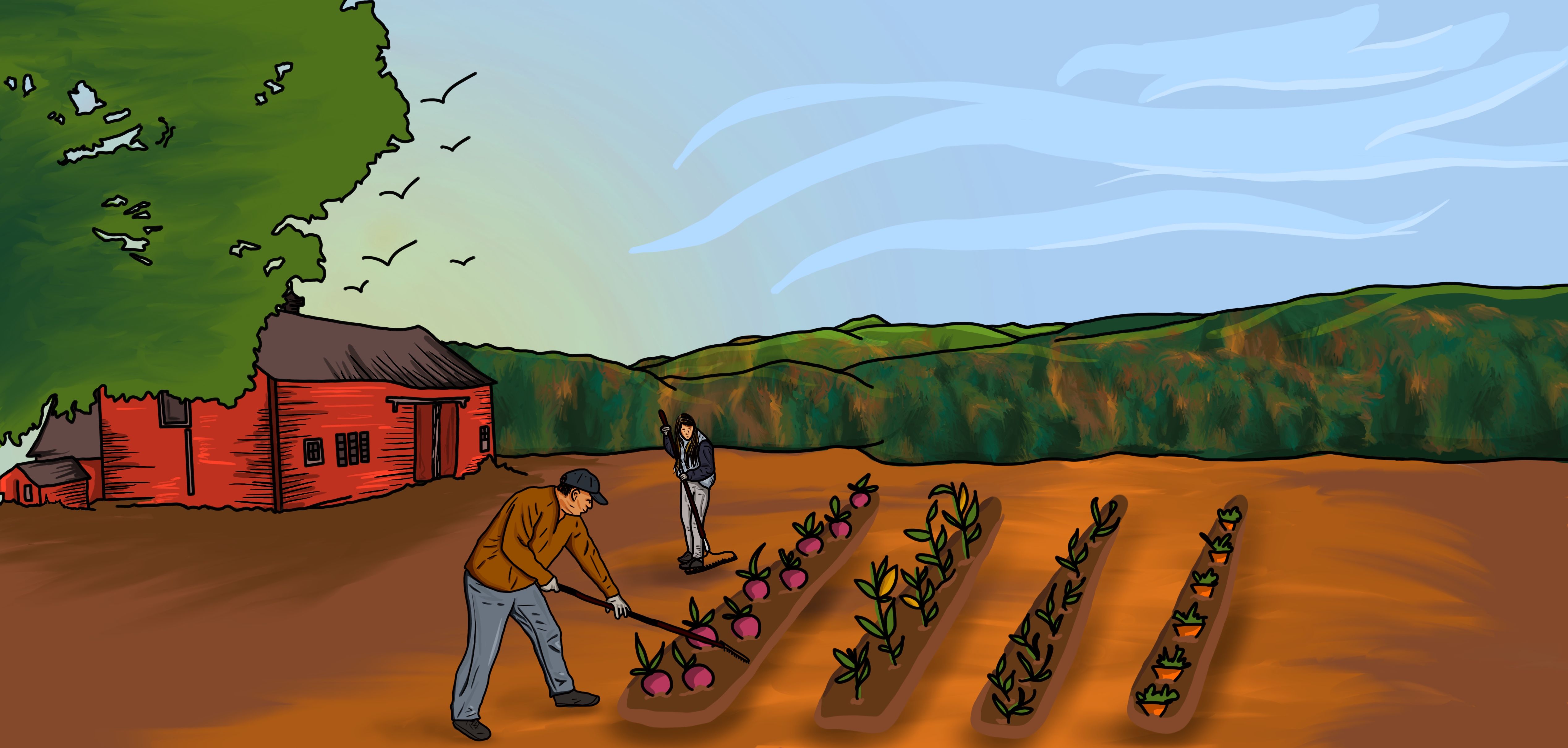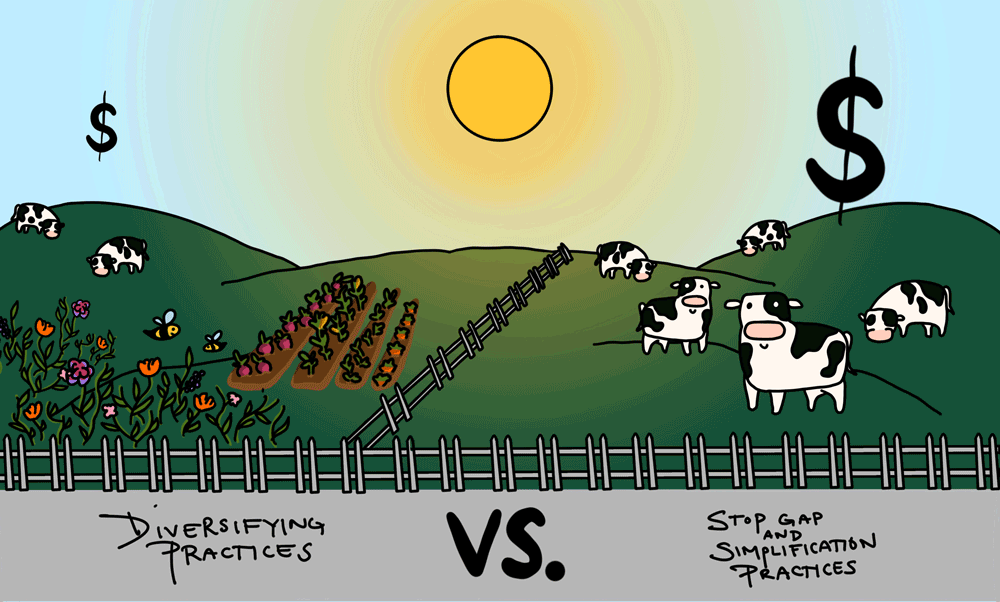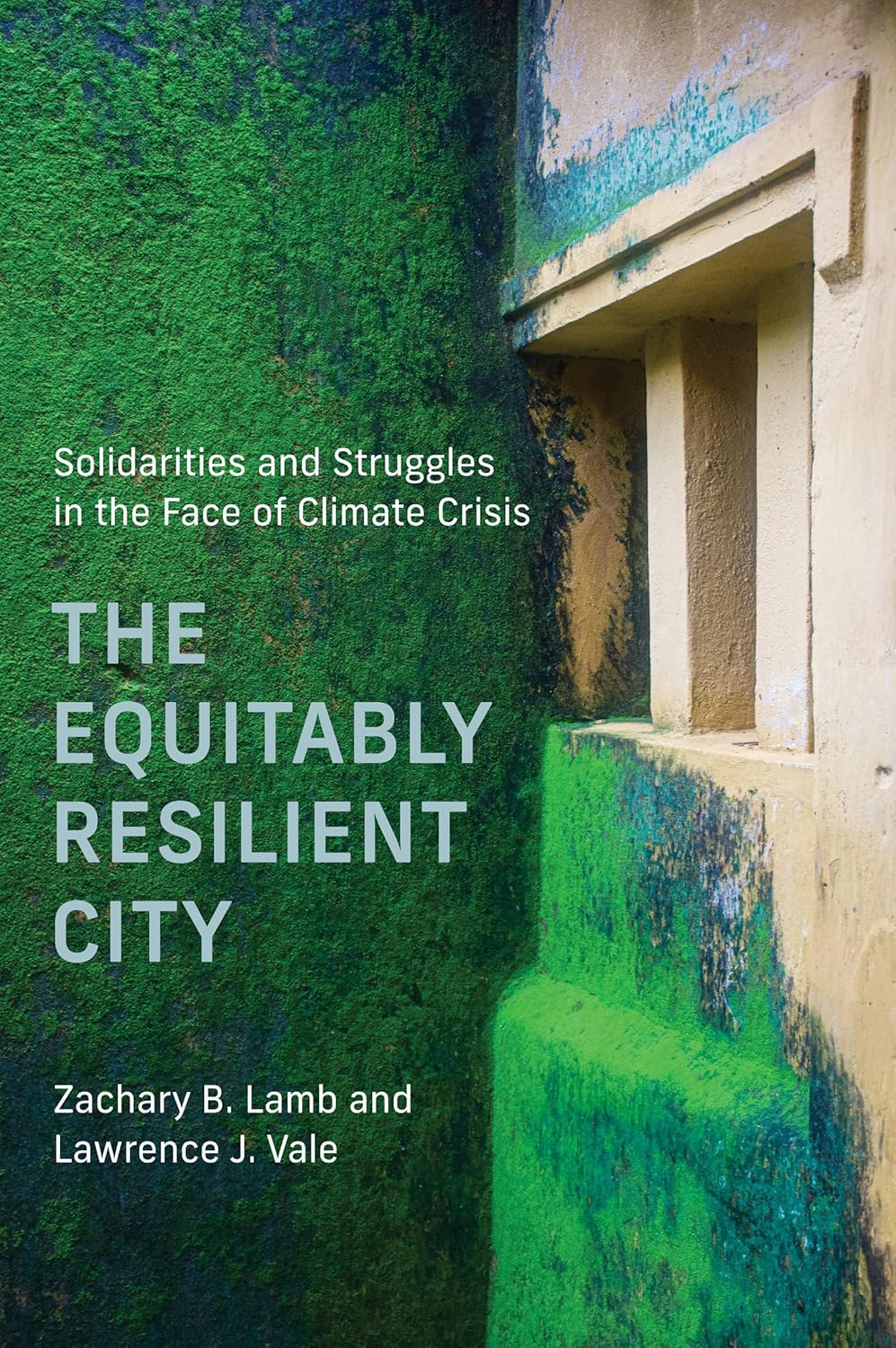Northern California farmers and climate change

Northern California farmers experience some of the most intense effects of climate change. Faced with unrelenting drought, wildfire, and changing weather patterns, they have no choice but to transition to climate friendly practices, like integrating crops and livestock and conserving water through more efficient irrigation. Yet, when Margiana Petersen-Rockney, a PhD candidate in the Department of Environmental Science, Policy, and Management at UC Berkeley, began interviewing these farmers about how they interact with the changing climate, she observed a dissonance: farmers would not publicly acknowledge belief in climate change, despite the actions they were taking to guard against it.
Long before farming became the focus of her academic work, Petersen-Rockney worked on her family’s farm in Rehoboth, Massachusetts. She went to college nearby, strategically planning her course schedule so she could spend Friday through Monday at home working the land. During that time, her family was faced with the prospect of losing their farm. To help out, Petersen-Rockney started a Community Supported Agriculture (CSA) program, selling vegetables to 60 families. Her effort helped save the farm and illustrated that a host of structural factors and lack of safety nets force many farmers to live extremely close to the margin.
As a researcher, Petersen-Rockney witnesses this precarity among the farmers she works with in California’s northernmost Siskiyou County. Not only do Siskiyou farmers live in poverty, but they also face the physical threats of climate change: climbing temperatures, reduced and unpredictable precipitation, and intense and frequent weather events like droughts and fires.
“In much of rural America, belief in anthropogenic climate change is pretty low,” says Petersen-Rockney. “But [farmers] are on the frontlines of having to deal with it.” Yet, many are reluctant to deviate from the dominant community narrative by admitting belief in climate change, fearing that their neighbors will shun them.
In a region already plagued by severe drought and water scarcity, many farmers are already implementing water-saving practices. Some farmers and ranchers employ stopgap solutions, like buying supplementary hay for cattle feed when their grass dries up or selling cattle early in a drought year to avoid rising production costs. Other farmers implement more proactive, long-term strategies to address the changing climate: they add organic material to the soil to help retain water, allow the grass to grow longer in rangeland to cool and shade the earth, revegetate land with native plants that can sequester carbon, and improve irrigation efficiency.
These agro-ecological strategies fall under the umbrella of “diversifying practices,” which build the capacity for biodiversity in the ecosystem (adapting to climate change) and help the soil store carbon (mitigating climate change). More traditional “simplifying practices,” on the other hand, attempt to maximize production by shifting toward just one or two types of crops and livestock. Capital intensive, simplifying practices entrench the need for external, nonrenewable inputs like seeds and chemicals. Simplifying practices also homogenize an ecosystem, reducing the ability of the farm to adapt to climate change and the ability of the soil to hold carbon.
Still, even as farmers adopt agro-ecological practices, many struggle to address climate threats with minimal financial, institutional, and water resources. In that context, neighborly reciprocity, often in the form of labor, is critical to sustain Siskiyou farms. For example, farmers told Petersen-Rockney that in extreme drought, their neighbors allowed them to herd livestock onto their own land to access fresh range and water springs.
Farmers also shared with Petersen-Rockney their experiences of ostracization, which they perceived were in direct response to using climate friendly practices. One farmer sold her cows and began rotating pigs and planting cover crops to manage water. Shortly after, her neighbors stopped helping her manage the irrigation ditch they shared. This is precisely the scenario many farmers fear.
“People would tell me things like, ‘Well, I actually do believe in climate change. But it's really important that you don't tell my neighbors that,’” says Petersen-Rockney. Farmers perceive that admitting to belief in climate change will drive away community support, yet they have to address climate issues so their farms do not collapse. This leaves farmers in an impossible bind.
Even though the physical risks of climate change are tangible and apparent, most Siskiyou farmers make the calculation that the social risk of being shunned is a much larger threat. Farmers fear that publicly expressing belief in climate change in their insular conservative community might cause them to be cut off from their neighbors. Instead, Petersen-Rockney heard many farmers attribute prolonged drought to natural fluctuations in the weather. “Farmers would tell me things like, ‘Oh, yeah, we're in a drier period, because the weather works in cycles. This is the drier cycle, and we'll have wetter cycles later.’” Framing and addressing climate change in terms of weather cycles protects farmers from having to directly acknowledge human-driven climate change, whether or not they believe in it.

A complex social context shapes farmers’ beliefs and the way they respond to their world. As recently as 2012, Siskiyou farmers reported less than a tenth of what the average California farmer earned. Many of these rural communities, including Siskiyou, have seen land consolidation on a massive scale and a decrease in the local tax base. Siskiyou farmers have watched as their rural health care was stripped away and their local community banks were replaced by multinational corporations.
“I saw the ways that the state has systematically facilitated capital accumulation that has marginalized rural people,” says Petersen-Rockney.
On top of that, many farmers are reacting to a history of receiving outsized blame as bad environmental actors. In the 1990s, loggers (many of whom were farmers trying to supplement their income) felt scapegoated for the endangerment of the northern spotted owl. The listing of the owl as endangered drove the final nail in the coffin of the logging industry, putting many farmers out of work, and prioritizing the owl over farmers’ own survival and livelihoods.
In the mid-2000s, salmon were listed as endangered. Many factors contributed to the decimation of salmon, but farmers, as visible, significant water users, took heat yet again for endangering wildlife.
“Everything that is done to manage a landscape or to interact with the land is changing the climate,” Petersen Rockney says. “And of course, humans have always been and will always be in relationship with the land.”
Many Siskiyou farmers still feel demonized at this crucial climate moment. They take blame for methane emissions, land use management, aquifer depletion, and forestry practices, all while they are barely keeping their farms running and families fed. To many of these farmers, acknowledging human-driven climate change means accepting yet another serving of undeserved blame for a complex web of intersecting environmental factors, many out of their control.
Yet, as Petersen-Rockney spoke to more farmers of different identities, she began to hear from people who openly admitted belief in climate change. Many of them were women and people of color.
“The way that power operates in these communities and within the structure of family households is that women are on the margin, socially,” Peteresen-Rockney says. Historically, men held the role of primary farmer or decision maker. As one male farmer put it to Petersen-Rockney, women are “not part of the good ol’ boys’ club.”
Farmers of color have also been forced to the outside of farming communities, systematically excluded from membership and financial assistance by organizations like the Farm Bureau and the Cattlemen’s Association, organizations made up primarily of white men.
Many women and farmers of color, already on the margins, intimated to Petersen-Rockney that they have less to lose by deviating from dominant norms. While white male farmers told Petersen-Rockney that they could never admit publicly that they believed in climate change, women and farmers of color had less at stake, and more of an opportunity to bring in new ideas.
The traditional public institutions that have excluded women and farmers of color usually support conventional simplifying practices, a reductionist approach to farming that does not encourage adaptation to a changing climate, explained Petersen-Rockney.
Women and farmers of color “have gone in a different direction, and maybe because they don't have access to those resources, they have more imperative to—or maybe they have no choice except to—employ more agro-ecological practices,” Petersen-Rockney says.
Excluded from traditional farming institutions, marginalized farmers are spearheading these efforts for sustainable agriculture, efforts that will determine whether farming has a future at all.
_ Katherine Raphael is a graduate student in the UC Berkeley School of Journalism
Design by Julia Torvi




